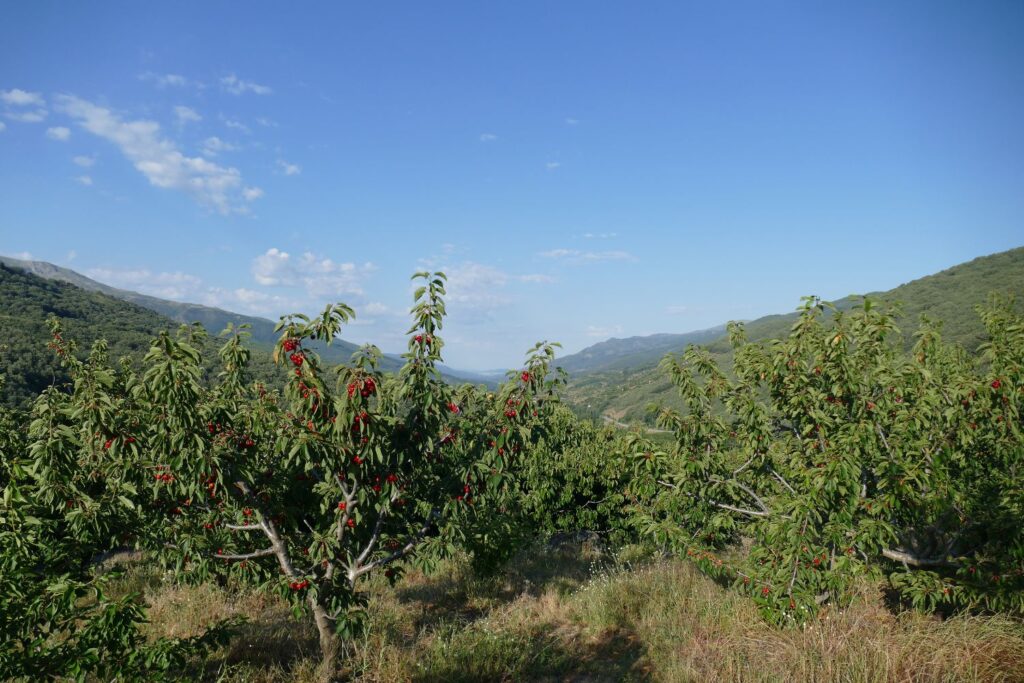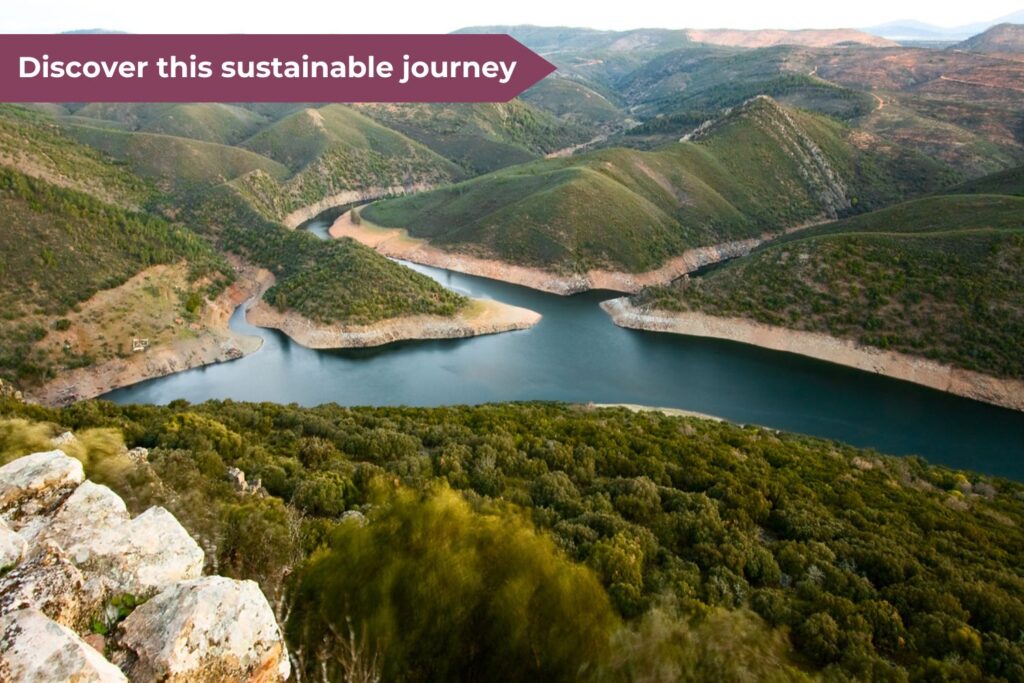By Caroline Mills
“My boyfriend Noel is the farmer. He went and picked these cherries this morning, so they’re very fresh,” says the young lady as I eye up a box of glossy-looking fruit. Almost an inch round, and ruby red, they appear irresistible.
“Would you like to try one?” she says. By appearance alone, I already plan to purchase the cherries grown within sight of the shop, but I try one anyway. The taste explosion as I bite into the plump, fruity flesh – sweet but with pleasant acidity – is intense.
I’m standing in the shop of Cerezas Morales, in Navaconcejo, one of the numerous villages along the Valle de Jerte where cherry production dominates cultural life in this part of Extremadura. The Morales family has been growing cherries in the valley for more than 40 years; it’s a farming tradition that’s been passed down generations. Cherry production is now in the hands of Noel.

The cherries I purchase have no stalks, as the cherry detaches from the stalk when picked. It’s a distinguishing feature of a Picota cherry, which can only be grown in the Valle del Jerte. The five varieties of cherry grown here have Protected Designation of Origin (PDO) status. Nowhere else in the world can claim to grow Picota cherries; they are unique to the region, and I’m delighted to buy them in situ, knowing my purchase is supporting the resident family.
“If you keep them in the fridge, they will last a week,” continues the young lady. “Unlikely,” I reply. So delicious are the cherries, they’ll be devoured long before the week is over!
I move on to another little warehouse in the village, where a small group of workers are grading cherries: sorting, sizing, and discarding anything that doesn’t match the desired quality.
Excited to experience Extremadura’s wonders for yourself? On this 13-day trip, you’ll explore Monfragüe National Park, the Sierra de Gata, and Mérida. You’ll stay in more sustainable accommodation and enjoy cultural experiences, explore Plasencia on a guided tour, and embark on a ham safari in Southwest Extremadura.

It’s cherry-picking season. The steep slopes of the mountainsides that frame the River Jerte are bustling with activity, bringing cherries down from the terraces for sorting, and selling. The Jerte Valley is the largest continuous production area of cherries in Europe, with more than a million cherry trees. Seeing the valley from the Mirador del Puente Becedas viewpoint, above the village of Jerte, makes this evident, with the valley and its cherry trees reaching into the distance for miles.
Cherries are only one of the foodie delights that are part of the cultural landscape of Extremadura, which is what makes a visit here so special. For me, discovering the artisan food and drink of a region is to understand its communities, while acknowledging that my purchases on holiday are supporting local families.

To the northwest of the Jerte Valley and the historic city of Plascencia is the Sierra de Gata. Here, the landscape is filled with olive groves. Some trees are young, tender, and newly planted; others display gnarled, ancient trunks, their bark furrowed like aged brows. These trees, hundreds of years old, have witnessed history; the Romans grew olives here 2,000 years ago, and the tradition continues. The olives grown are Manzanilla Cacareña, a variety native to the province of Cáceres that produces a golden yellow extra virgin olive oil that’s highly prized. Like Picota cherries, the olive oil, too, has PDO status.
So do many other products that are grown or produced in Extremadura, including honey, paprika, lamb, beef, wine, and cheese, specifically goat and sheep cheese like the PDO Torta del Casar. This cheese from the Cáceres province of Extremadura must be produced using the milk of two breeds of sheep. While the rind is hard, the centre is oozingly soft and can be scooped out like cream.

Include Extremadura’s climate to grow figs (the largest fig-growing area in Spain) and stone fruits like peaches, almonds, walnuts, chestnuts, and rice – grown in glistening, irrigated paddy fields that appear like an oasis in the Guadiana Valley – and there’s a regional menu bursting with colour, flavour, and texture.
Arguably, Extremadura’s most flavoursome product is its Ibérico pork and ham. The native Iberian pig breed is reared free-range beneath the holm oak trees of Extremadura’s dehesa (an agroforestry-managed landscape), fattened over many months on acorns. This sustainable method of production produces a delicious, marbled meat.

Wandering around the pretty stone arcades of Trujillo’s Plaza Mayor, I amble into Mesón La Troya, one of the numerous restaurants in the town specialising in regional cuisine using local produce. The coolness of the century-old restaurant beneath vaulted arches, rustic with traditional pottery plates hanging on the walls, is welcoming. The regional menu even more so. Here, alongside Extremadura’s renowned lamb stew, are multiple cuts of Ibérico pork unheard of in standard [supermarket] parlance. Pluma (a feather-steak), Lagarto (thin strips of rib-loin), and Presa (above the shoulder) of pork are options. So, too, Secreto, a tender cut of unrivalled quality, so named because butchers would keep this cut for themselves!

Upon leaving the restaurant, I return to my box of cherries – what’s left of them. As the website for Cerezas Morales says, “By buying our cherries, you support the local economy.” That, for me, is the cherry on top when selecting a sustainable holiday in Extremadura.
Feeling inspired? Experience Extremadura’s wealth of gastronomy for yourself by booking our 13-day Purest Spain: Ecotourism in Extremadura itinerary.
Editorial submission – 24th June 2024









